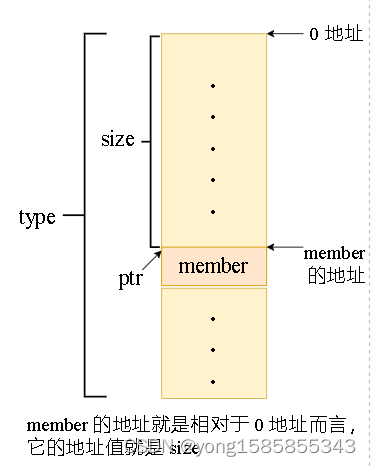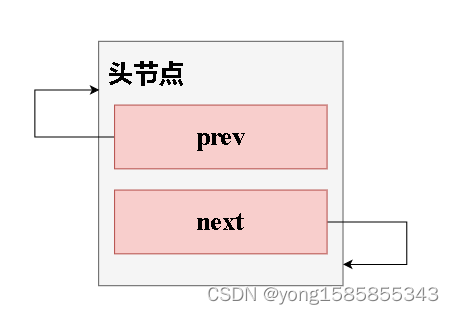0. Linux 的内核的数据结构,应该属 list.h 中的 list_head 最重要、最常见。
list_head是一个双向的,带有伪头部(哨兵)的双向环形链表。- 这个双向链表的每个节点的类型可以不一样
应用:
- 内核的定时器使用链表的话,包括用户态的定时器,都会首选
list_head。 list_head虽然是内核的数据结构,但是比较特殊,将它复制到用户态,也可以直接用 gcc 编译通过运行。- 之前在看 openwrt 中有一个 uloop 的用户态的库,就是使用
list_head
说在前面:
#define offsetof(TYPE, MEMBER) ((size_t) &((TYPE *)0)->MEMBER)
这个宏就是为了计算下面的 size,原理:将地址 0 的位置强制标记为结构体指针的类型,那么它的member成员变量所对应的地址就是size的值。

那么我们经常看到的 contain_of 这个宏就好解释了:
#define container_of(ptr, type, member) ({ \
const typeof( ((type *)0)->member ) *__mptr = (ptr); \
(type *)( (char *)__mptr - offsetof(type,member) );})
- 中间的那行:
ptr是member的指针,是一个指针赋值,将ptr指针赋值给__mptr - 最后面的一行:因为
offsetof(type,member)计算了size的值,而__mptr记录着member的地址,它往前移动size的值就是结构体开始的地址,再将它强制转为为结构体的指针类型,就得到了我们想要的结构体。 - 那要
ptr就可以,为什么要多一个中间变量__mptr?因为这是一个指针赋值给指针,在 C 编译器,指针赋值给指针,如果两边的指针类型不匹配,需要强制将右值的指针的类型进行手动转换,否则会报错!这个就是一个检验报错的机制。
typeof( ((type *)0)->member )
- 返回
member的类型。在这里没有多余的意思。
1. 笔记
a. 结构体定义
结构体的成员是两个指针变量
// include/linux/types.h
struct list_head {
struct list_head *next, *prev;
};
b. 初始化
// include/linux/list.h
/*
* Simple doubly linked list implementation.
*
* Some of the internal functions ("__xxx") are useful when
* manipulating whole lists rather than single entries, as
* sometimes we already know the next/prev entries and we can
* generate better code by using them directly rather than
* using the generic single-entry routines.
*/
#define LIST_HEAD_INIT(name) { &(name), &(name) }
#define LIST_HEAD(name) \
struct list_head name = LIST_HEAD_INIT(name)
static inline void INIT_LIST_HEAD(struct list_head *list)
{
list->next = list;
list->prev = list;
}
上面三个都是初始化函数,创建一个结构体实例,这个结构体就是链表的头部。一般这个链表是不保存数据的,只是起一个哨兵的作用。实例中图示如下,创建一个结构体示例,类型为struct list_head,指针 prev 指向自身结构体(struct list_head):

c. 链表的增
/*
* 在 prev 和 next 之间插入一个节点 new
*/
#ifndef CONFIG_DEBUG_LIST
static inline void __list_add(struct list_head *new,
struct list_head *prev,
struct list_head *next)
{
next->prev = new;
new->next = next;
new->prev = prev;
prev->next = new;
}
#else
extern void __list_add(struct list_head *new,
struct list_head *prev,
struct list_head *next);
#endif
/**
* 在链表头部(链表头)后面插入
*/
static inline void list_add(struct list_head *new, struct list_head *head)
{
__list_add(new, head, head->next);
}
/**
* 在链表尾部后面插入
*/
static inline void list_add_tail(struct list_head *new, struct list_head *head)
{
__list_add(new, head->prev, head);
}
d. 链表的删
/*
* 删除 prev 和 next 之间的节点(但是不释放内存)
*/
static inline void __list_del(struct list_head * prev, struct list_head * next)
{
next->prev = prev;
prev->next = next;
}
/**
* 删除节点 entry ,但是不释放内存
*/
#ifndef CONFIG_DEBUG_LIST
static inline void __list_del_entry(struct list_head *entry)
{
__list_del(entry->prev, entry->next);
}
/**
* 删除节点 entry ,但是不释放内存
* 同时设置 entry 的 prev, next 指针为非法
*/
static inline void list_del(struct list_head *entry)
{
__list_del(entry->prev, entry->next);
entry->next = LIST_POISON1;
entry->prev = LIST_POISON2;
}
#else
extern void __list_del_entry(struct list_head *entry);
extern void list_del(struct list_head *entry);
#endif
e. 链表的查
前置内容:
// 一个包含 list_head 的结构体定义
struct ListNode
{
int val;
// list.h 内定义的核心结构体
struct list_head mylist;
};
// 它的示例这样写:
struct ListNode first_node;
struct ListNode second_node;
member:指成员变量,struct list_head 类型的名字——mylisttype: 指包含 struct list_head 的结构体类型——struct ListNodeptr: 指已经实例化链表的节点的 strust list_head 的指针head:一般指链表的头节点中的 strust list_head 的指针pos:这个得看函数就是遍历的临时变量,类似于(for(pos = head; pos != NULL; pos = pos.next)),主要是区分类型。- 在
list_for_each_entry_safe这样的函数,它的类型是链表节点的指针 - 如果是
list_for_each_safe它是 strust list_head 的指针
- 在
最常用的两个,遍历的是结构体(包含 struct list_head 和数据成员的结构体):
/**
* list_for_each_entry - iterate over list of given type
* @pos: the type * to use as a loop cursor.
* @head: the head for your list.
* @member: the name of the list_head within the struct.
*/
#define list_for_each_entry(pos, head, member) \
for (pos = list_first_entry(head, typeof(*pos), member); \
&pos->member != (head); \
pos = list_next_entry(pos, member))
/**
* list_for_each_entry_safe - iterate over list of given type safe against removal of list entry
* @pos: the type * to use as a loop cursor.
* @n: another type * to use as temporary storage
* @head: the head for your list.
* @member: the name of the list_head within the struct.
*/
#define list_for_each_entry_safe(pos, n, head, member) \
for (pos = list_first_entry(head, typeof(*pos), member), \
n = list_next_entry(pos, member); \
&pos->member != (head); \
pos = n, n = list_next_entry(n, member))
f. 一些技巧
- 如果全部使用
list_add:在哨兵节点后插入节点,可以作stack使用(先进后出) - 如果全部使用
list_add_tail:在哨兵节点前面插入节点,可以做queue使用(先进先出)
2. 一个例子
#include "list.h"
#include <stdio.h>
// 一个 entry 的结构体定义
struct ListNode
{
int val;
// list.h 内定义的核心结构体
struct list_head mylist;
};
int main()
{
// 初始化一个哨兵头节点
LIST_HEAD(head_node);
// 第一个有用节点
struct ListNode first_node =
{
.val = 1,
.mylist = LIST_HEAD_INIT(first_node.mylist)
};
list_add(&first_node.mylist, &head_node);
printf("%d\n", first_node.val);
// 第二个有用节点
struct ListNode second_node =
{
.val = 2,
.mylist = LIST_HEAD_INIT(second_node.mylist)
};
list_add(&second_node.mylist, &head_node);
printf("%d\n", second_node.val);
// 不能使用 for 循环,不然会造成死循环,还没有时间看为什么,估计是可以解决的
// for (int i = 0; i < 5; i++)
{
struct ListNode node =
{
.val = 10,
.mylist = LIST_HEAD_INIT(node.mylist)
};
list_add(&node.mylist, &head_node);
}
/* 头文件宏下的
* @pos: entry 结构体的实例指针,
* @head:一般正常地使用,就是哨兵节点的指针。如果自己使用一些奇淫技巧,那么就自己确定他的指针位置
* @member:entry 结构体内的 struct list_head 的变量名
*/
struct ListNode *pos_ptr = NULL;
list_for_each_entry(pos_ptr, &head_node, mylist)
{
printf("%d\n", pos_ptr->val);
}
return 0;
}
2. 头文件源码(每个版本不一样)
- 文件直接从内核里导出来,可以在用户态使用。
list.h
/* SPDX-License-Identifier: GPL-2.0 */
#ifndef LIST_H
#define LIST_H
#include <stdbool.h>
#include <stddef.h>
/* Are two types/vars the same type (ignoring qualifiers)? */
#define __same_type(a, b) __builtin_types_compatible_p(typeof(a), typeof(b))
/**
* container_of - cast a member of a structure out to the containing structure
* @ptr: the pointer to the member.
* @type: the type of the container struct this is embedded in.
* @member: the name of the member within the struct.
*
*/
#define container_of(ptr, type, member) ({ \
void *__mptr = (void *)(ptr); \
_Static_assert(__same_type(*(ptr), ((type *)0)->member) || \
__same_type(*(ptr), void), \
"pointer type mismatch in container_of()"); \
((type *)(__mptr - offsetof(type, member))); })
#define LIST_POISON1 ((void *) 0x100)
#define LIST_POISON2 ((void *) 0x122)
/*
* Circular doubly linked list implementation.
*
* Some of the internal functions ("__xxx") are useful when
* manipulating whole lists rather than single entries, as
* sometimes we already know the next/prev entries and we can
* generate better code by using them directly rather than
* using the generic single-entry routines.
*/
struct list_head {
struct list_head *next, *prev;
};
#define LIST_HEAD_INIT(name) { &(name), &(name) }
#define LIST_HEAD(name) \
struct list_head name = LIST_HEAD_INIT(name)
/**
* INIT_LIST_HEAD - Initialize a list_head structure
* @list: list_head structure to be initialized.
*
* Initializes the list_head to point to itself. If it is a list header,
* the result is an empty list.
*/
static inline void INIT_LIST_HEAD(struct list_head *list)
{
list->next = list;
list->prev = list;
}
/*
* Insert a new entry between two known consecutive entries.
*
* This is only for internal list manipulation where we know
* the prev/next entries already!
*/
static inline void __list_add(struct list_head *new,
struct list_head *prev,
struct list_head *next)
{
next->prev = new;
new->next = next;
new->prev = prev;
prev->next = new;
}
/**
* list_add - add a new entry
* @new: new entry to be added
* @head: list head to add it after
*
* Insert a new entry after the specified head.
* This is good for implementing stacks.
*/
static inline void list_add(struct list_head *new, struct list_head *head)
{
__list_add(new, head, head->next);
}
/**
* list_add_tail - add a new entry
* @new: new entry to be added
* @head: list head to add it before
*
* Insert a new entry before the specified head.
* This is useful for implementing queues.
*/
static inline void list_add_tail(struct list_head *new, struct list_head *head)
{
__list_add(new, head->prev, head);
}
/*
* Delete a list entry by making the prev/next entries
* point to each other.
*
* This is only for internal list manipulation where we know
* the prev/next entries already!
*/
static inline void __list_del(struct list_head *prev, struct list_head *next)
{
next->prev = prev;
prev->next = next;
}
static inline void __list_del_entry(struct list_head *entry)
{
__list_del(entry->prev, entry->next);
}
/**
* list_del - deletes entry from list.
* @entry: the element to delete from the list.
* Note: list_empty() on entry does not return true after this, the entry is
* in an undefined state.
*/
static inline void list_del(struct list_head *entry)
{
__list_del_entry(entry);
entry->next = LIST_POISON1;
entry->prev = LIST_POISON2;
}
/**
* list_is_head - tests whether @list is the list @head
* @list: the entry to test
* @head: the head of the list
*/
static inline int list_is_head(const struct list_head *list, const struct list_head *head)
{
return list == head;
}
/**
* list_empty - tests whether a list is empty
* @head: the list to test.
*/
static inline int list_empty(const struct list_head *head)
{
return head->next == head;
}
/**
* list_entry - get the struct for this entry
* @ptr: the &struct list_head pointer.
* @type: the type of the struct this is embedded in.
* @member: the name of the list_head within the struct.
*/
#define list_entry(ptr, type, member) \
container_of(ptr, type, member)
/**
* list_first_entry - get the first element from a list
* @ptr: the list head to take the element from.
* @type: the type of the struct this is embedded in.
* @member: the name of the list_head within the struct.
*
* Note, that list is expected to be not empty.
*/
#define list_first_entry(ptr, type, member) \
list_entry((ptr)->next, type, member)
/**
* list_next_entry - get the next element in list
* @pos: the type * to cursor
* @member: the name of the list_head within the struct.
*/
#define list_next_entry(pos, member) \
list_entry((pos)->member.next, typeof(*(pos)), member)
/**
* list_entry_is_head - test if the entry points to the head of the list
* @pos: the type * to cursor
* @head: the head for your list.
* @member: the name of the list_head within the struct.
*/
#define list_entry_is_head(pos, head, member) \
(&pos->member == (head))
/**
* list_for_each_entry - iterate over list of given type
* @pos: the type * to use as a loop cursor.
* @head: the head for your list.
* @member: the name of the list_head within the struct.
*/
#define list_for_each_entry(pos, head, member) \
for (pos = list_first_entry(head, typeof(*pos), member); \
!list_entry_is_head(pos, head, member); \
pos = list_next_entry(pos, member))
/**
* list_for_each_entry_safe - iterate over list of given type. Safe against removal of list entry
* @pos: the type * to use as a loop cursor.
* @n: another type * to use as temporary storage
* @head: the head for your list.
* @member: the name of the list_head within the struct.
*/
#define list_for_each_entry_safe(pos, n, head, member) \
for (pos = list_first_entry(head, typeof(*pos), member), \
n = list_next_entry(pos, member); \
!list_entry_is_head(pos, head, member); \
pos = n, n = list_next_entry(n, member))
#endif /* LIST_H */
























 969
969











 被折叠的 条评论
为什么被折叠?
被折叠的 条评论
为什么被折叠?








